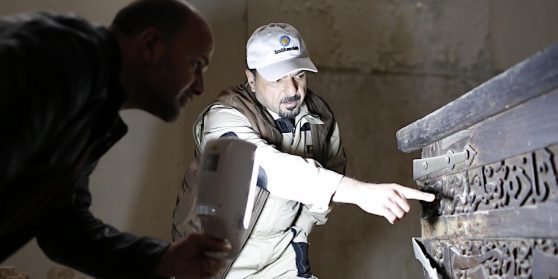National Museum of Asian Art Announces Third Program in Its Series on the Protection of Cultural Heritage, “Protecting Cultural Heritage under Siege”

April 15, 2024 | National Museum of Asian Art
Panel Will Address Pressing Issues in the Cultural Heritage Field, Especially in Zones of Armed Conflict
The Smithsonian’s National Museum of Asian Art has announced a program “Protecting Cultural Heritage under Siege” that is designed to help the public understand pressing issues facing the cultural heritage field, especially in protecting and preserving tangible cultural heritage and those who steward it in zones of armed conflict and violence. The event takes place April 24 from 6 to 7:30 p.m., in the museum’s Meyer Auditorium. It is free and open to the public; registration is required.
The panelists will examine the linked political, economic, humanitarian, philanthropic, military and administrative challenges of protecting cultural heritage. The challenges are hardly new, but the catalyst for this discussion is the continuing and widespread destruction and looting of heritage in recent decades.
Participants include:
- Thomas G. Weiss (moderator), Presidential Professor Emeritus of Political Science at the CUNY Graduate Center
- Irina Bokova, former director-general of UNESCO
- Valéry Freland, executive director of the International Alliance for the Protection of Heritage in Conflict Areas (ALIPH)
- Gil J. Stein, professor of Near Eastern archaeology at the University of Chicago and director of the Chicago Center for Cultural Heritage Preservation
- Jennifer M. Welsh, Canada 150 Research Chair in Global Governance and Security at McGill University
The program is supported by Carnegie Corporation of New York.
Related Report
This event corresponds with the April 24 publication of a 45-page report “Protecting International Cultural Heritage and Personnel under Siege: Problems and Prospects for US Organizations” by Thomas G. Weiss (lead author). The report is the culmination of a two-year long research project undertaken by the museum with support from the Carnegie Corporation. The purpose of the study was to survey and understand the pressing issues facing U.S. organizations working to protect and preserve tangible cultural heritage in zones of armed conflict; and to propose steps that would improve the field’s effectiveness. The Smithsonian is a leader in this field. The report provides a framework for considering the future of the field of cultural heritage protection and preservation. The research included in-depth interviews with some 60 practitioners and experts, working nationally and around the world.
The report will be published on the National Museum of Asian Art’s website April 24. It is the result of the dedicated efforts of lead author Weiss who worked with a small cross-institutional team at the Smithsonian.
Coinciding with this publication date, the National Museum of Asian Art is hosting a closed-door convening of experts in the field—including from the Smithsonian—to collaborate and move to action some of the steps suggested in the report.
Cultural Heritage Preservation and Global Partnership Initiatives
This program and related report are the latest example of the National Museum of Asian Art’s portfolio in cultural heritage preservation and global partnerships.
The first two public programs in the National Museum of Asian Art’s series on the protection of cultural heritage included:
- Jan. 27, 2024, program: Museums and Cultural Heritage Protection: A Case Study of Repatriations to Yemen
- Related to NMAA’s historic partnership with the Republic of Yemen Government to care for Yemeni objects repatriated by the U.S. government
- Nov. 4, 2023, program: Reclaiming Cambodia’s Cultural Heritage: Provenance Research in Action
- Following the signing of a memorandum of understanding with the Ministry of Culture and Fine Arts of Cambodia, which outlines ways the museum will seek to collaborate with the Ministry to address pressing issues in Cambodia’s cultural heritage sector
About the Smithsonian’s National Museum of Asian Art
The Smithsonian’s National Museum of Asian Art is committed to preserving, exhibiting, researching and interpreting art in ways that deepen our collective understanding of Asia, the United States and the world. Home to more than 46,000 objects, the museum stewards one of North America’s largest and most comprehensive collections of Asian art, with works dating from antiquity to the present from China, Japan, Korea, South Asia, Southeast Asia and the Islamic world. Its rich holdings bring the arts of Asia into direct dialogue with an important collection of 19th- and early 20th-century art from the United States, providing an essential platform for creative collaboration and cultural exchange between the U.S., Asia and the Middle East.
Beginning with a 1906 gift that paved the way for the museum’s opening in 1923, the National Museum of Asian Art is a leading resource for visitors, students and scholars in the United States and internationally. Its galleries, laboratories, archives and library are located on the National Mall in Washington, D.C., and are part of the world’s largest museum complex, which typically reports more than 27 million visits each year. The museum is free and open to the public 364 days a year (closed Dec. 25), making its exhibitions, programs, learning opportunities and digital initiatives accessible to global audiences.
For Press Inquiries
PressAsia@si.edu
Phone: (202) 633-0271
Fax: (202) 633-0043
Office of Marketing and Communications
National Museum of Asian Art
PO Box 37012, MRC 707
Washington, DC 20013-7012

